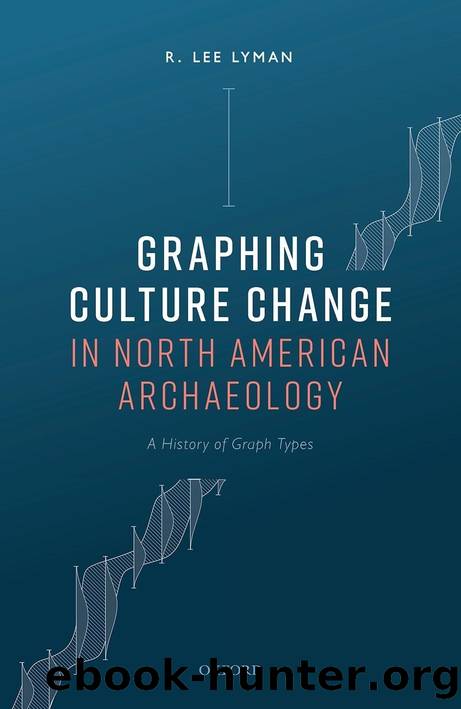Graphing Culture Change in North American Archaeology by Lyman R. Lee;

Author:Lyman, R. Lee; [Lyman, R. Lee]
Language: eng
Format: epub
Publisher: Oxford University Press USA - OSO
Published: 2021-04-20T00:00:00+00:00
9.2 Graphing Time and Space
As noted earlier, a major goal of archaeological research virtually since its formal beginnings in the mid-nineteenth century is to explain the spatial and temporal distributions of artifact forms. During the early twentieth century there were some thoughts or notions (what some might categorize as theories) about how and why culture change looked the way it did when it was graphed. Wissler (1923) and Chapin (1925, 1928) thought they had at least the beginnings of a notion about why culture changed the way it did (Figures 6.7 and 6.8). And Wissler had another idea that one might consider a theoryâthe age-area model of culture change (Kroeber 1931; see also Dixon 1928: 67â69). He found it quite useful for explaining Nelsonâs (1916) observations on ceramic change in the American Southwest, and thus he reprinted Nelsonâs (1919) figure (Figure 7.21) (Wissler 1919). The age-area model as employed by Wissler and Nelson (and others; see later) rested on the process of diffusion.
Archaeologists who during the early twentieth century were using graphs and tables to summarize temporal shifts in frequencies of specimens over time were, without always or fully realizing it, summarizing change in content (the particular kinds or types represented), richness (N of kinds or types), evenness (N of specimens per kind), and heterogeneity (combination of richness and evenness). Often their analytical goal was to construct a cultural chronology, such as with James Ford (Chapter 8); in other (rare) cases the goal was to document and explain culture change as evidenced by changes in material culture. As we saw with Clark Wissler (1923) and Stuart Chapin (1925, 1928) in particular but also Kroeber (1944), anthropologists in general had no well-developed theory of why any of the graphed variablesâcontent (which types were present), richness, evenness, heterogeneityâmight change in value over time other than simple historical accidents or innovations or diffusions (for detailed examination of these deficiencies, see Dunnell 1989; Rindos 1989). In this sense, the graphs depicted empirical data, or perhaps an interpretation thereof (as with many diamond-shaped spindles or seriograms), and had minimal explicit theoretical implications. The one area that did receive a bit of attention, and that produced several graphs of some pedagogical and analytical value and is thus worth reprinting here, involved a form of the age-area model.
The first diagram to explicitly graph the expected spatio-temporal distribution of artifacts was provided by James Ford (1952). He reasoned that there would be some âtime lagâ between the source location of an artifact type (or a cultural trait of any scale) and its first appearance in another area (Ford 1952: 329). In addition, his model depicted three possibilities (Figure 9.2). First, the diffusing type could occur in greater absolute abundance the farther from its source (type C in Figure 9.2). Second, Ford thought it most likely that the diffusing type would occur in lower absolute abundance the farther from its source (types A and B in Figure 9.2). And third, some types may diffuse more rapidly than others (type A diffuses more rapidly than type B in Figure 9.
Download
This site does not store any files on its server. We only index and link to content provided by other sites. Please contact the content providers to delete copyright contents if any and email us, we'll remove relevant links or contents immediately.
Sapiens: A Brief History of Humankind by Yuval Noah Harari(13046)
The Tidewater Tales by John Barth(12029)
Do No Harm Stories of Life, Death and Brain Surgery by Henry Marsh(6335)
Mastermind: How to Think Like Sherlock Holmes by Maria Konnikova(6233)
The Thirst by Nesbo Jo(5783)
Why We Sleep: Unlocking the Power of Sleep and Dreams by Matthew Walker(5639)
Sapiens by Yuval Noah Harari(4534)
Life 3.0: Being Human in the Age of Artificial Intelligence by Tegmark Max(4502)
The Longevity Diet by Valter Longo(4445)
The Rules Do Not Apply by Ariel Levy(3904)
The Immortal Life of Henrietta Lacks by Rebecca Skloot(3824)
The Body: A Guide for Occupants by Bill Bryson(3797)
Why We Sleep by Matthew Walker(3770)
Animal Frequency by Melissa Alvarez(3752)
Yoga Anatomy by Kaminoff Leslie(3699)
Barron's AP Biology by Goldberg M.S. Deborah T(3630)
The Hacking of the American Mind by Robert H. Lustig(3579)
All Creatures Great and Small by James Herriot(3512)
Yoga Anatomy by Leslie Kaminoff & Amy Matthews(3394)
